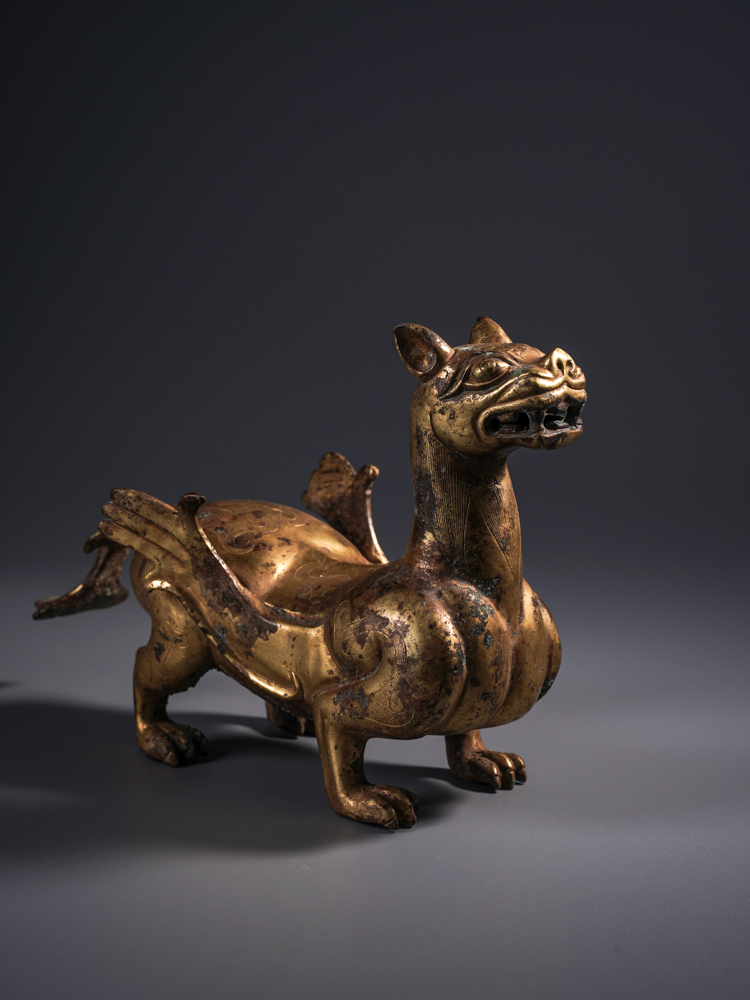The original article was published in "Journal of the National Museum of China" Issue 11, 2022
Author: Yu Luyang You Jiahao
China Cultural Relics Information Consulting Center (Beijing)
【Abstract】The branch-ring covered firing method is a method in which porcelain is placed on branch-ring kiln furniture for firing. It was used more frequently during the Song Dynasty and became popular in a wider area. This article examines issues related to the branch-circle overlaying method during the Song Dynasty from an archaeological perspective. The branch rings were divided into two types: disc-shaped branch rings and annular combined branch rings. The age of each type of branch ring was verified. It was believed that previous studies generally had the problem of premature age determination, and then a periodic study was carried out.After discussing the direction and path of the spread, it is believed that Ding kiln is in an advantageous and dominant position in the spread of the branch circle, and it should be the founding kiln of the disc-shaped branch circle. The installation design concept of the Hutian kiln's annular combined branch ring also originated from the Ding kiln and spread to the surrounding areas of central Jiangxi, eastern Hunan and western Fujian. Kiln farms in other areas of Fujian have partially accepted the cultural factors of the Hutian kiln's ring-shaped combined branches and redeveloped it in a sublated manner.
【Key words】Song Dynasty; branch ring covering firing method; Ding kiln; Hutian kiln; Mangkou
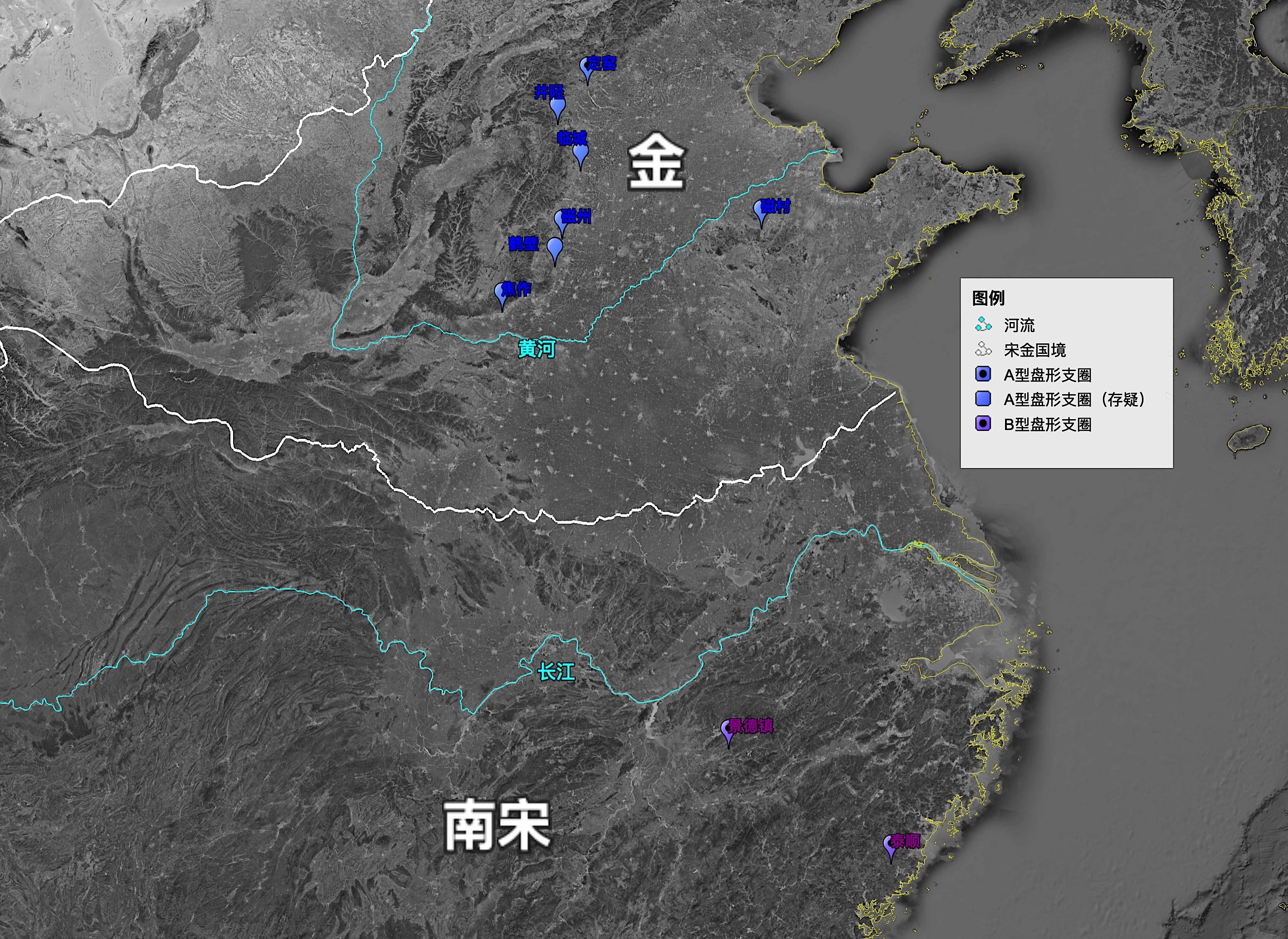
Firing porcelain with the mouth rim facing down was a common method during the Song Dynasty. It mainly includes glaze mouth firing and branch ring firing. The former belongs to the category of overlapping firing, and methods such as scraping circles on the inner bottom, placing nail spacers and sticky nails are often used to avoid the adhesion of multiple pieces of the same shape. The latter is to cover the utensils on the branch ring kiln for firing. It is a type of porcelain firing method that is used more frequently and is popular in a wider area. It is the focus of this article's research.Since the rim of the objects fired using the latter method has no glaze, forming a "mang mouth", and the decoration of the kiln furniture is also relatively special, the academic community pays more attention to the branch ring covering firing method, and research articles on it are not uncommon. However, because no key evidence has been found to determine the specific appearance time of various types of branch-ring kiln furniture, the development and spread of the branch-ring overfiring method has never been well resolved. This article intends to use the existing archaeological materials and combine it with the information collected by the author's surveys in various places to rethink the issues related to the branch-circle overlaying method from an archaeological perspective.
1. Types and distribution of branch circles
The support ring is a kiln furniture that supports the over-fired utensils. It has two functions: supporting and spacing the utensils [1]. It is the most important material carrier for the study of the branch-ring over-firing method. It is mostly made of porcelain clay. According to the difference in overall shape, the branch rings can be roughly divided into two categories. The first type can be generally called disc-shaped branch rings, and the second type is annular combined branch rings.
(1) Disc-shaped support ring
Most of them have oblique straight walls, thin sidewalls, and the overall shape is like a plate, and some are bottomless and hollow. There are also shallow bowls, bowls and other shapes, which will not be distinguished in this article. Porcelain body firing. It can be divided into two types according to whether there are multi-level edges on the inner wall.
A: No multi-level edges.
This type of branch ring was found at the Ding Kiln, Jingxing Kiln, Guantai Cizhou Kiln, Yuxian Ciyaopo Kiln and Xiuwu Dangyangyu Kiln sites. For example, JCAT4 ⑤ b: 323 was unearthed in Dingyaojian Ciling Area A in 2009 (Figure 1: 1), and 16JHD: 39[2] (Figure 1: 2) was discovered in the 2016 kiln site survey on the east slope of the Jingxing River in 1987 Y6 ②: 6 (Figure 1: 3), Y5 ②: 72 [3] (Figure 1: 4) unearthed from the Cizhou kiln site in Guantai in 2016, and examples from the archaeological survey of Ciyao Po Kiln in Yuxian County [4] (Figure 1 :5) and examples unearthed from the archaeological excavation of Xiuwudangyangyu kiln site from 2003 to 2004 [5] (Figure 1: 6).
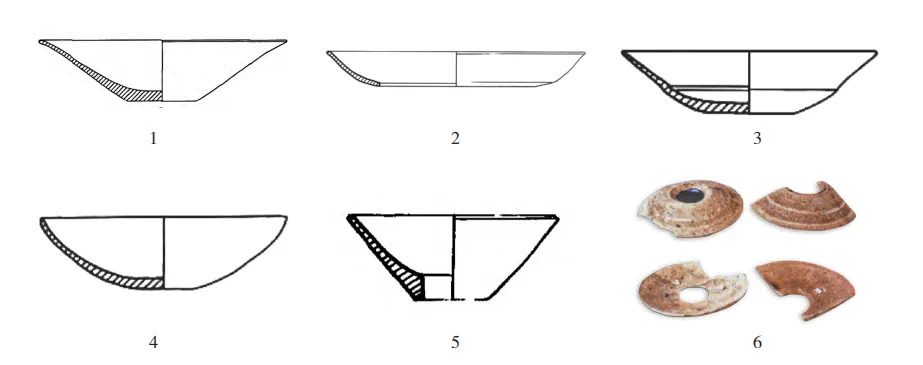
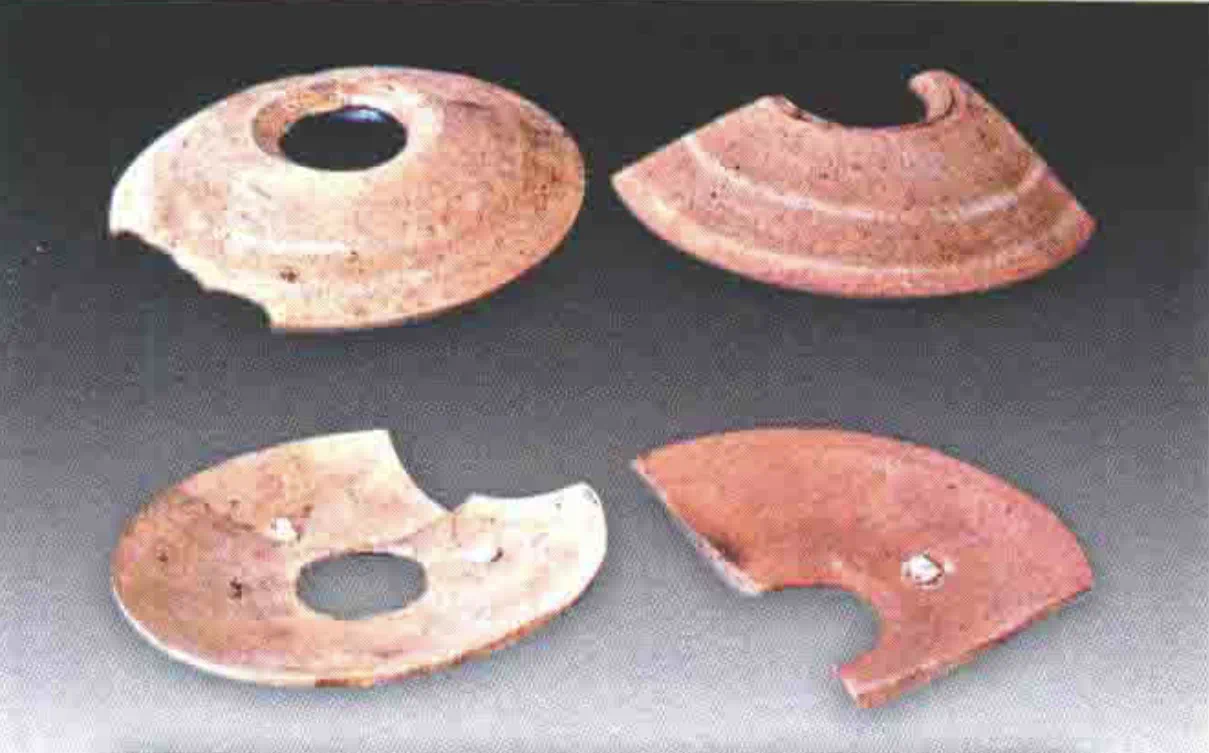
6
Figure 1 A-type disc-shaped support ring
1. Jianciling Area A Example 2. Jingxing River East Slope Example 3, 4. Guantai Cizhou Example 5. Yuxian Ciyao Slope Example 6. Xiuwudangyang Valley Example
B: multi-level edge.
It is mostly found at the Hutian kiln site in Jingdezhen and is also known as the "multi-level pot". For example, 97GT4 was unearthed from 1988 to 1999 at the Hutian kiln site in Jingdezhen ②: 203 [6] (Figure 2: 1) and the example unearthed from the Yuta kiln site in Taishun [7] (Figure 2: 2)
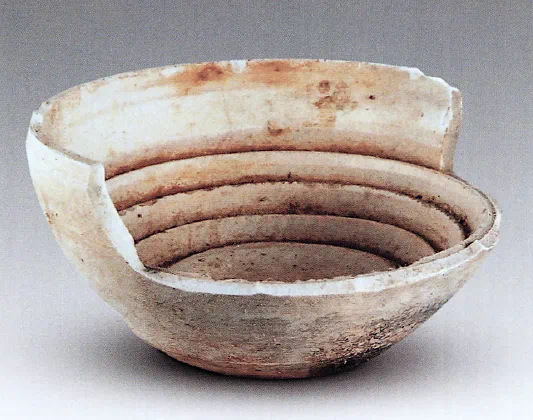
1
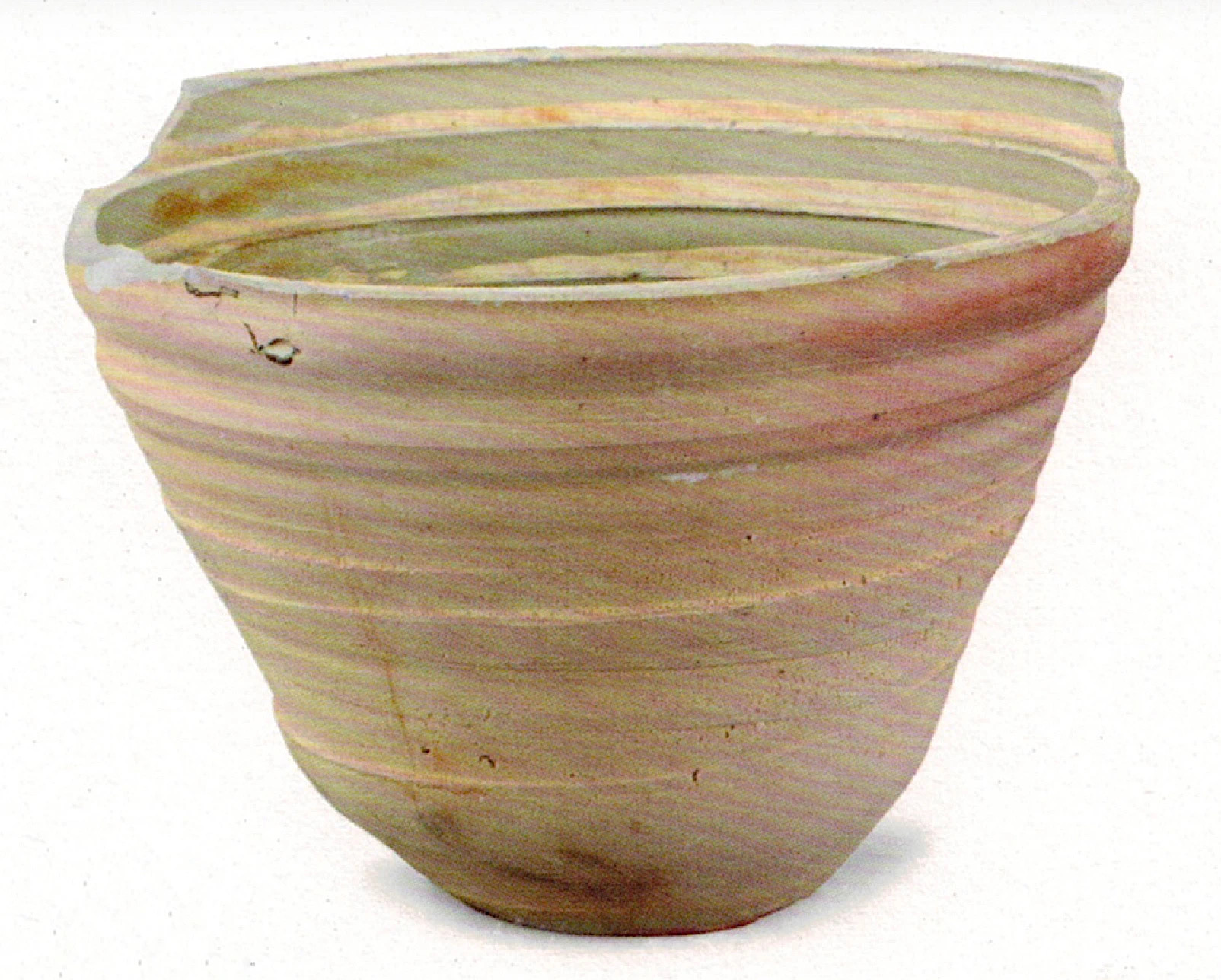
2
Figure 2 B-type disc-shaped support ring
1. Jingdezhen Hutian Case 2. Taishun Jade Pagoda Case
(2) Annular combined branch ring
According to the difference in overall shape, it is divided into two types.
A: Positive L shape. According to whether the outer wall and the corner of the edge are convex, they are divided into two subtypes.
Aa: raised. The angle between the inner wall and the exit edge is greater than or equal to 90°.
Currently only found in kilns in northern areas. A large number of branch rings of this type have been found in the Ding kiln ruins. The caliber size is different from the height of the outer wall and is no longer divided into different types. For example, JCAT2 West ④: 159 was unearthed in Dingyaojianciling Area A in 2009 [8] (Figure 3: 1). In addition, Jingxing Kiln [9] (Picture 3: 2), Lincheng Nanchengcun Kiln [10] (Picture 3: 3), Guantai Cizhou Kiln [11], Hebi Ji Kiln [12] (Picture 3: 4), Kiln sites such as Jiaozuo kiln [13], Pacun kiln [14], Cicun kiln [15] (Figure 3:5), and Kongwa kiln [16] are also distributed.
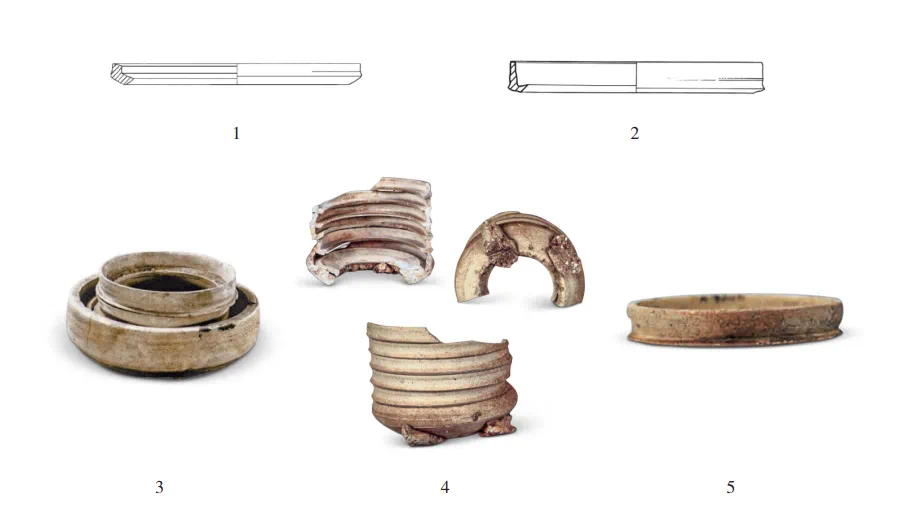
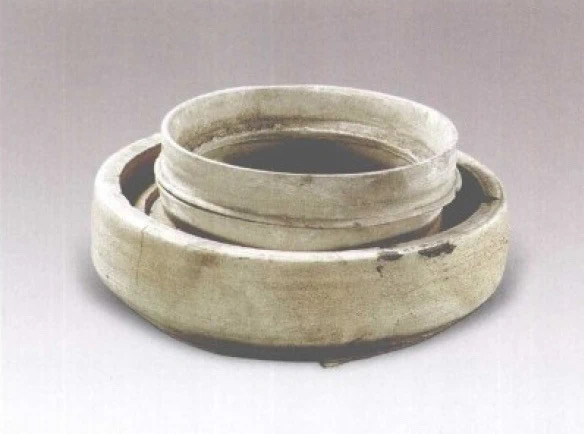
3
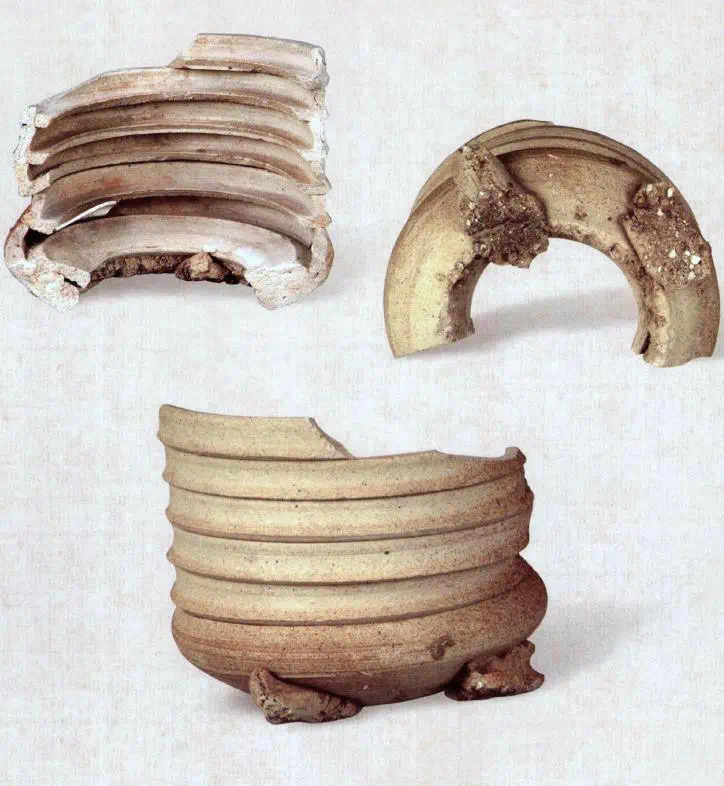
4
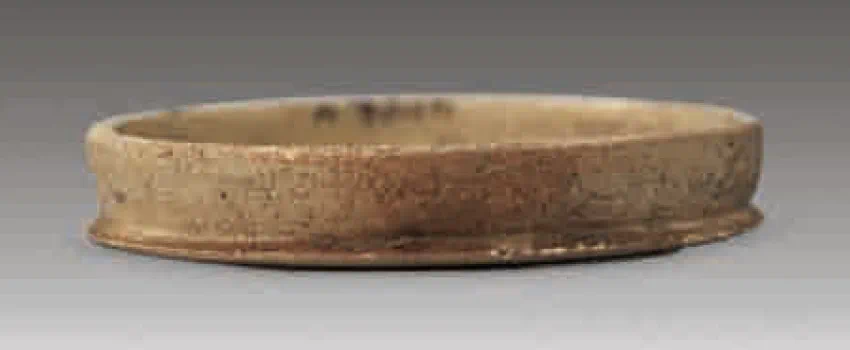
5
Figure 3 Aa type annular combination support ring
1. Jianciling District A example 2. Jingxing example 3. Lincheng Nanchengcun example 4. Hebiji example 5. Cicun example
Ab: Not raised. The angle between the inner wall and the outgoing edge is approximately 90°.
At present, it is only found in kilns in southern areas. A large number of branch rings of this type were found at the Hutian Kiln Site in Jingdezhen, such as 95AT2 ②: 500 [17] excavated from the Hutian Kiln Site in Jingdezhen from 1988 to 1999 (Figure 4:1) and examples from the collection of Jingdezhen Kiln Museum [18] (Figure 4:2). In addition, it can also be found in Fengcheng Shijiang Qianshi Kiln[19] (Figure 4:3), Jizhou Yonghe Kiln[20], Jing'an Yajishan Kiln[21], Fengxin Kiln Changli Kiln[22], Ningdu Kiln [23], Yongfeng Shankou Kiln [24], Nanfeng Baishe Kiln [25], Pingxiang Nakeng Kiln [26], Yiyang Yangwuling Kiln [27], Changsha Jiumu Kiln [28] in Hunan ( Figure 4: 4), Liling Zhonggutang Kiln [29], Leiyang Kiln [30] and Hengdong Kiln [31], Guangzhuang Maodian Kiln [32] (Figure 4: 5) and Changting Nanshan Kiln in Fujian [33].
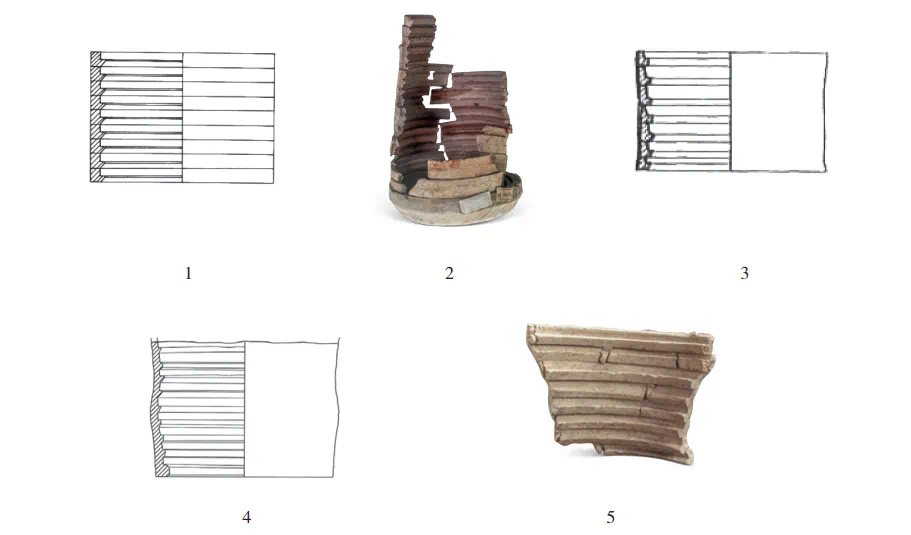
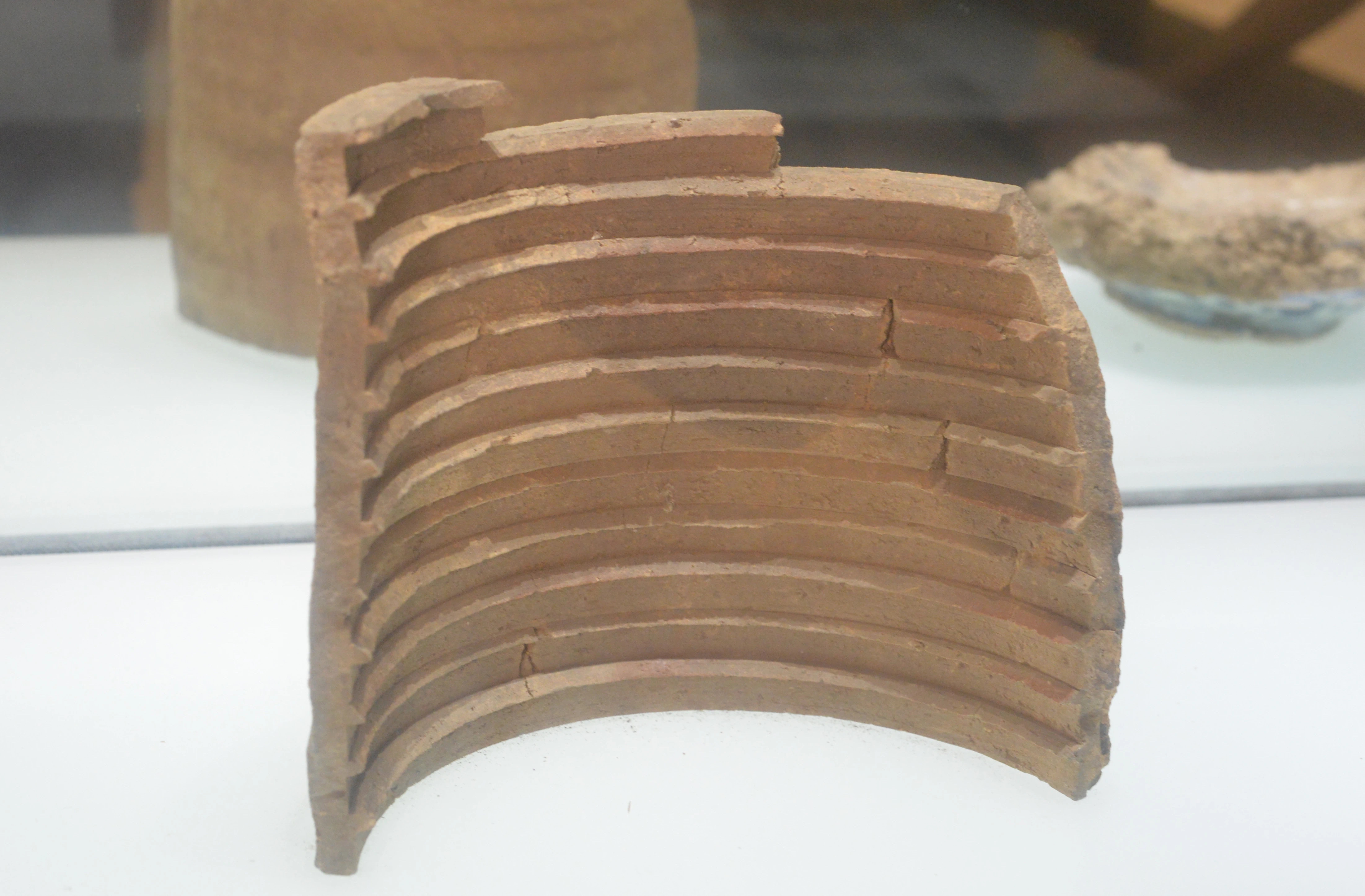
5
Figure 4 Ab type annular combination support ring
1. Jingdezhen Hutian Example 2. Jingdezhen Kiln Museum Example 3. Fengcheng Shijiang Example 4. Changsha Jiumu Example 5. Guangshimaodian Example
B: Inverted L shape.
It is mostly found in kilns in Fujian, such as Wuyishan Bengkeng kiln[34] (Figure 5:1), Jianou kiln[35], Zhouning Siqiao kiln[36], Zherong Qinglan noodle kiln[37], Shunchang Guanshan kiln Kiln [38], Jianyang Shuiji Kiln [39], Jianou Xiaosong Kiln [40], Putian Kiln [41] (Figure 5:2), Nan'an Nankeng Kiln [42], Anxi Kuidou Kiln [43], Dehua kiln [44] (Figure 5:3), Quanzhou Dongmen kiln [45], Tongantingxi kiln [46] and so on. In addition, specimens of this type of branch ring are also found at the Longquan Xikou kiln site [47] (Figure 5: 4).

Figure 5 B-type annular combination support ring
1. Wuyi Mountain collapse case 2. Putian case 3. Dehua case 4. Longquan Xikou case
2. The age of use of various types of branch circles
The most direct evidence for judging how the branch ring kiln furniture was decorated and fired is the specimen where the utensils and the branch ring are adhered together. And because the dating scale of the artifacts is more accurate, such specimens can also provide important basis for the age of use of various branch rings and branch ring covering methods. However, given that the number and types of adherent specimens are insufficient, reasonable inferences usually need to be made based on factors such as the shape of artifacts and kiln furniture with traces of burning.
(1) Disc-shaped support ring
A-type disc-shaped branch rings are more common in Dingyao sites. According to the conclusion of the 2009 archaeological excavation, this type appeared in the second phase of the Jianciling kiln area, that is, the middle Northern Song Dynasty [the first year of Tianxi (1017) to the eighth year of Yuanfeng (1085)], and continued until the early Jin Dynasty [The second year of Jingkang (1127) to the fifth year of Zhenglong (1160)] [48] . In the book "Guantai Cizhou Kiln Site", scholars believe that this type of branch circle began in the latter part of the second period [from the first year of Jingguo's reign (1101) to the eighth year of Huangtong (1148)] and the third period [ From the first year of Tiande (1149) to the third year of Xingding (1219)].According to the excavation results in 2003, the disc-shaped branch ring of Dangyangyu kiln appeared in the later period of the first phase [from the first year of Jingguo (1101) to the second year of Jingkang (1127)], and traces of concentric circles can be seen on the inner wall of the branch ring. , it is speculated that the utensils were placed on the inner wall. After entering the second period [from the second year of Jingkang (1127) to the first year of Dading (1161)], the branch ring was turned upside down and utensils were placed on the outer wall of the branch ring [49].
Adhesive archaeological specimens of A-type disc-shaped support rings are relatively rare. From the folk materials collected from some Ding kiln sites, it can be seen that this type of support ring is placed in a sagger with the small mouth facing down, and the inner wall can be covered with three to three-inch rings of different calibers. Four flat-bottomed dishes and three to four belly plates or bowls. The quality of the glaze on the artifacts is better. Examples with decorative patterns include those with banana leaf patterns engraved on the outer wall and duck patterns engraved on the inner wall. The overall style is closer to the Ding kiln products of the late Northern Song Dynasty. In addition, many small plates with flat bottoms and sloping walls were unearthed from the same strata as the plate-shaped branch rings at the Dangyangyu Kiln site, which are similar to those unearthed from the tomb of Liu Chaozong in Linzhou in the second year of Zhenghe (1112). The excavators It is thought that a disk-shaped support ring was used for firing. Therefore, there is reason to believe that the A-type disc-shaped branch ring was used at least as early as the late Northern Song Dynasty, and the lower limit is roughly the middle of the Jin Dynasty.
B-type disc-shaped branch rings are frequently unearthed from the Hutian kiln site in Jingdezhen. Scholars believe in the book "Jingdezhen Hutian Kiln Site" that the Hutian kiln's use of this type of kiln furniture to decorate Mangkou wares appeared around the middle of the Northern Song Dynasty, and in the latter part of the third period [Jianzhong Jingguo first year (1101) to Jingkang II year (1127)] became widely popular. Liu Xinyuan first proposed that this type only appeared in the early Southern Song Dynasty [51], and later believed that it should belong to the late Northern Song Dynasty to the early Southern Song Dynasty [52]. The utensils adhered to the B-shaped disc-shaped support ring are mainly flat-bottomed dishes and ring-footed bowls, and the decorations are mostly carved with local characteristics of Hutian.The report did not provide specific basis for the dating of these artifacts. The flat-bottomed dish is 99H·F1:208[53] belonging to the Hutian kiln site (Fig. 6:1) and the example in the Jingdezhen Kiln Museum (Fig. 6:2). Both of them are similar to those unearthed from the Nanhai No. 1 shipwreck (around 1183). [54] (Figure 6:3) are basically consistent with the later examples unearthed from the Jinyu Village cellar in Suining. Most of the bowls with ring feet are carved on the outer wall, and specimens of the adhered objects include 97GT4 ③: 200 [55] (Figure 6: 4). This type of product is rarely found outside the kiln site.

Figure 6 B-type disc-shaped support ring adhesion specimens and comparison materials
1. 4. Jingdezhen Hutian Example 2. Jingdezhen Kiln Museum Example 3. Nanhai No. 1 Example
It should be noted that utensils with awnings do not only point to the branch-ring burning method, but utensils made using branch-ring burning must have awns on the edges. Therefore, the awning is used to determine whether it is branch-ring burning. Necessary and insufficient conditions. Among the blue and white porcelain unearthed from tombs in the Northern Song Dynasty that have been found so far, those with Mangkou include the jars and bowls unearthed from the tomb of Xiao Fujun in Ningcheng in the eighth year of Xianyong period of Liao Dynasty (1072) [56] (Figure 7: 1, 2) , the flat-bottomed dish unearthed from Wuyi Tomb in the sixth year of Yuanfeng of the Song Dynasty (1083) [57] (Figure 7:3), the seventh year of Yuanyou of the Song Dynasty (1092) The flat-bottomed dish unearthed from the tomb of Zhang Zhihe in Quanjiao [58] (Picture 7:4), the flat-bottomed dish unearthed from the tomb of Shi Shi in Poyang in the first year of Song Zhenghe (1111) (Picture 7:5), the flat-bottomed dish unearthed from the Shi family's tomb in Poyang in the first year of Song Zhenghe's reign (1111) (Picture 7:5), Song Zhenghe's The tureen unearthed from the tomb of Yan Liangzuo and his wife in Macheng in December of the third year of the year (1114) (Figure 7:6) is the same as that of the second year of Jingkang of the Song Dynasty (1127). The bowl unearthed from Zhang's tomb in Wuyuan [61] (Figure 7:7).
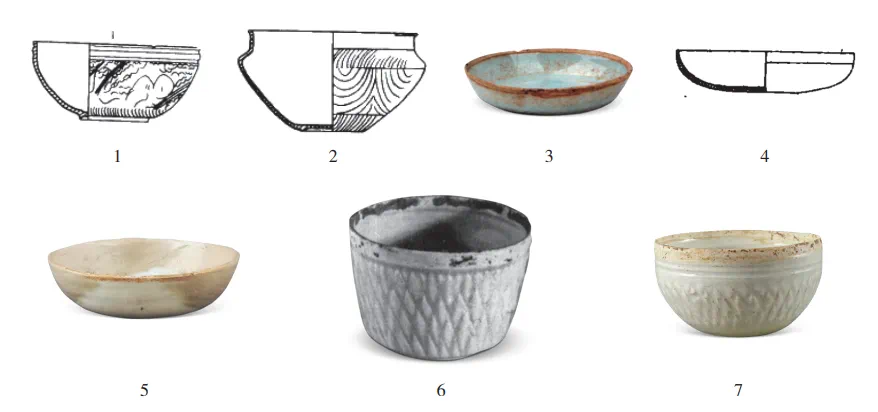
Figure 7: Mangkou tools unearthed from the Chronicle Tomb of the Northern Song Dynasty
1. 2. Example of Xiao Fujun’s Tomb 3. Example of Wuyi Tomb 4. Example of Quanjiao Tomb 5. Example of Poyang Tomb 6. Example of Macheng Tomb 7. Example of Wuyuan Tomb
The flat-bottomed dish from the Wuyi Tomb is an early example of a branch-ring covered-burning vessel that is often cited in academic circles. However, from the newly published clear pictures of the actual object, it can be seen that the factors of the deeply folded belly, thick body and thick glaze of this vessel are typical of the Southern Song Dynasty, and are similar to those of the South China Sea. The unearthed vessel No. 61 (Figure 6: 3) belongs to the same type of product, and its shape is quite different from the popular flat-bottomed dishes in the late Northern Song Dynasty. Therefore, it may be a mixture of later products.
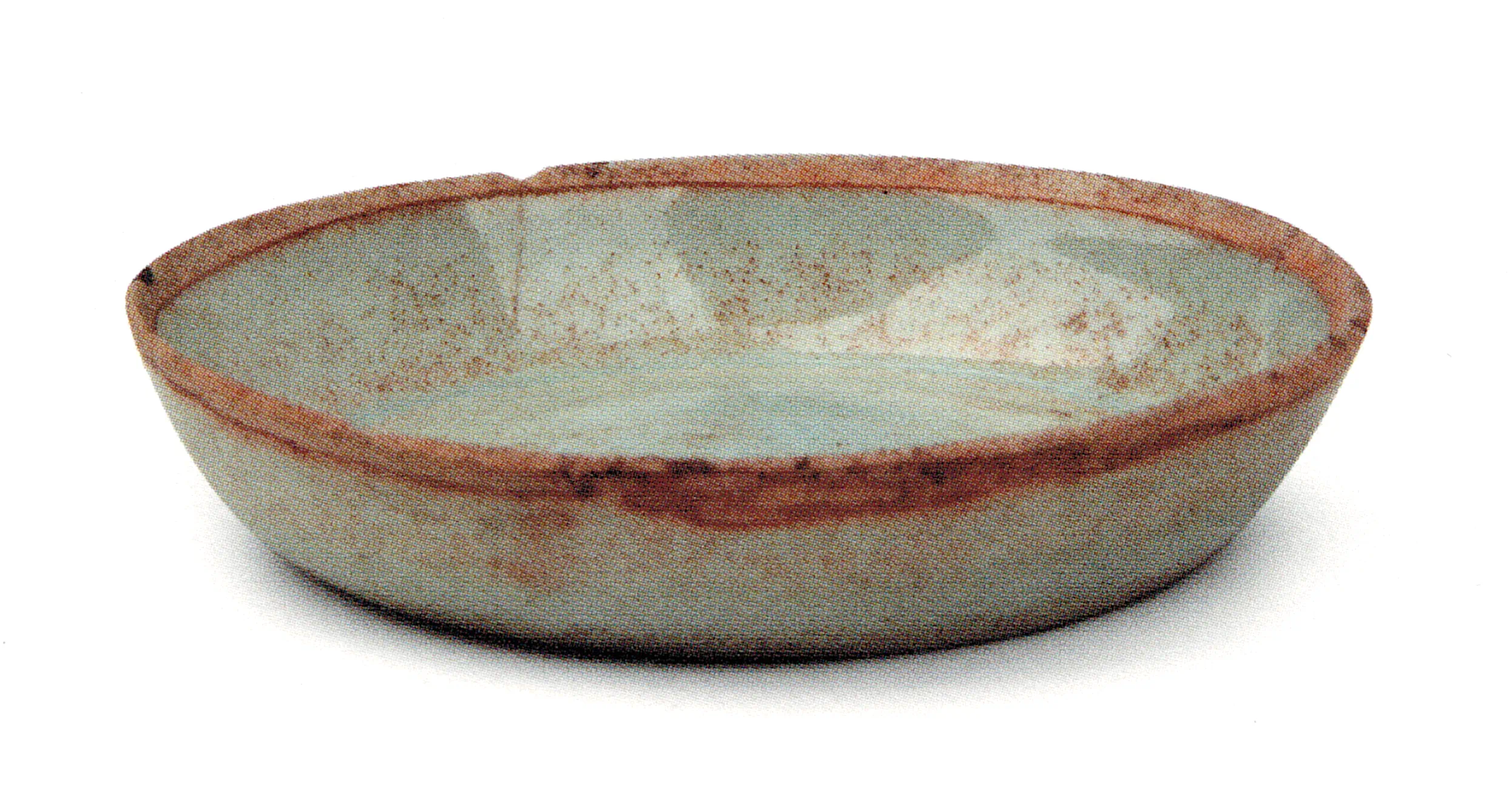
Figure 6: 3 flat-bottomed plates from Wuyi Tomb
The jars and bowls unearthed from the tomb of Xiao Fujun in Ningcheng are also Mangkou vessels. By observing the characteristics of similar collections from various places, it can be seen that the soles of the mango-mouthed vessels from these tombs are all fully glazed, and the glaze is accumulated around the mouth edges. From this, it can be judged that it should be overfired. However, it should be noted that there are currently very few adherent specimens of over-fired pots and bowls found at various kiln sites. The shape of the disc-shaped support ring is not suitable for firing this type of utensils. Its converging mouth or vertically deep folded belly shape makes it difficult to assemble it with the same type of utensils of different sizes or other dishes and dishes. Therefore, it is preliminarily judged that it did not use branch-type kiln furniture for decoration and firing.
What deserves attention are the flat-bottomed dishes unearthed from Zhang Zhihe's tomb in Quanjiao and Shi's tomb in Poyang. No picture material has been released for the former, but judging from the text description, it may be a similar product to the latter. It is currently difficult to determine the specific origin of the two [63], and they have not been found in other tomb materials. Since all the clues about the use of B-shaped disc-shaped branch rings before the middle of the Southern Song Dynasty are limited to these two flat-bottomed dishes from the late Northern Song Dynasty (1092 and 1111), there is reason to believe that these two artifacts, for which the information is not comprehensive, belong to The firing of type B branch ring is temporarily doubtful. In summary, the evidence that the B-type disc-shaped branch ring was used as early as the Northern Song Dynasty is currently not very sufficient. Judging from the current materials, compared with the possibility that this kind of decoration method appeared and disappeared on a small scale in the late Northern Song Dynasty, the credibility that it began in the early and middle Southern Song Dynasty (1162-1189) should be higher.
(2) Annular combined branch ring
Aa type annular combination support ring is widely used in kilns in northern areas. Materials from the archaeological excavation of Ding kiln in 2009 show that the shape of this type began to be determined in the third period of the Jianciling kiln area, that is, the late Northern Song Dynasty [from the first year of Yuanyou (1086) to the second year of Jingkang (1127)]. The fourth period (Jin Dynasty) became the most mainstream of decorated and fired kiln furniture.
No adhesion specimens of this type of annular branch were found to have characteristics of the Northern Song Dynasty. For example, there are several large bowls unearthed in Area A of Jianciling 09JCAT4 South⑤:3 with many ribs on the inner wall and engraved water-wave fish patterns on the inner bottom [64] (Figure 8:1). They are basically the same type of products as those unearthed in the Nong'an cellar. The "Dading Tongbao" [65] was also found in the cellar, so it can be seen that this type of bowl should be dated to the late Jin Dynasty. The inner wall of the adherent specimen artifact in the folk collection is engraved with a whirlwind pattern (Figure 8: 2), which is basically the same as the one unearthed in Haifeng, Huanghua (T54 ④ Xiatuqiangdonggou: 1). The same ruins unit is accompanied by a ring with lotus pattern of broken branches carved in Ding kiln. The plate [66] was also found in the ruins of the ancient city of Jining Road, Ulanqab, no earlier than the late Jin Dynasty [67].Another printed folded plate in a folk collection is a typical vessel from the middle and late Jin Dynasty (Figure 8:3), and can also correspond to the vessels unearthed from the Nong'an cellar. The author has found many adhesion specimens of this type in scattered cultural relics. The various characteristics of the adhesion artifacts are close to the above three items, and none are even close to those unearthed from early Jin Dynasty dating tombs.
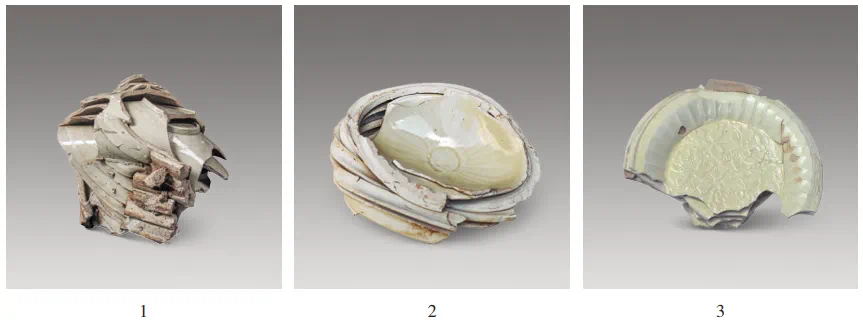

1
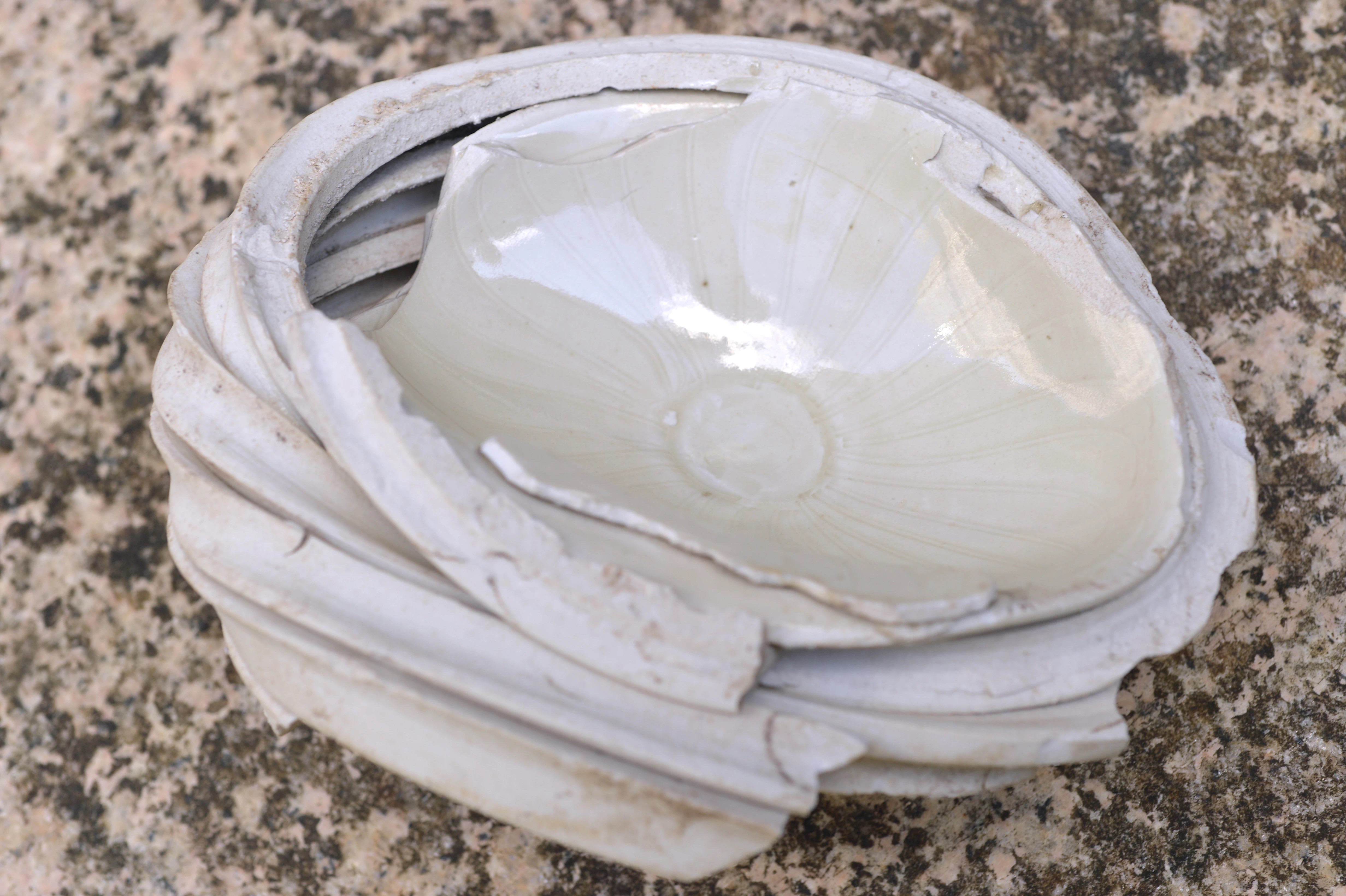
2
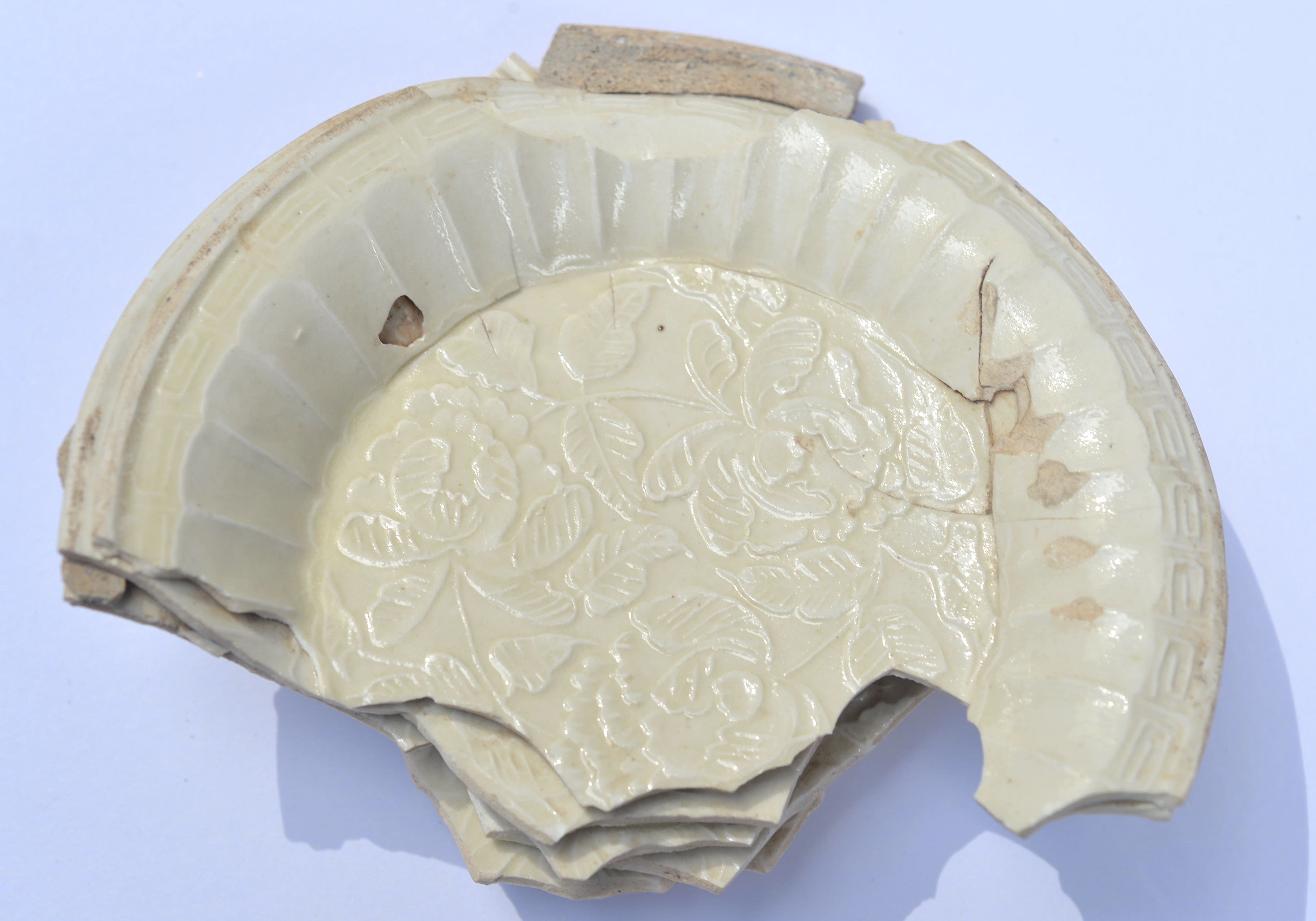
3
Figure 8 Aa type annular combined branch ring adhesion specimen
1. Examples from Area A of Jianciling 2, 3. Examples from private collections
Aa-type annular combined branch ring adhesion specimens are rarely found in kiln sites other than the Ding kiln site. It is possible to date the Mangkou ware unearthed from three kiln sites in Lincheng, Hebiji and Cicun that only have Aa-shaped annular combined branches. Among them, the decorations of Lincheng kiln and Hebi Ji kiln are mostly in the fine printing style of Ding kiln, and they are clearly dated to the middle and late Jin Dynasty. The shapes of various Mangkou wares from the Hebi kiln are basically the same as those from the Ding kiln in the late Jin Dynasty. According to the author's investigation and research, no various types of utensils with early Jin Dynasty characteristics were found at the Huayan Temple kiln site in Cicun where the branch circle was unearthed. There were many white porcelain clay circle bowls and astringent rings accompanying the branch circle. The black-glazed convex-lined jars and other objects are compared with the late Jin Dynasty chroniclers [68].This shows that the age when this type of branch ring firing technology spread to these three kilns should be no earlier than the middle of the Jin Dynasty.
In addition, A-type disc-shaped branch rings and the engraved white porcelain popular in Ding kiln in the early Jin Dynasty were unearthed from Ciyao Po Kiln in Yuxian County, which is close to the Ding kiln site. Ding kiln fine print style vessels in the middle and late dynasty have not been found. Based on the basic coverage of Ding kiln style utensils and kiln furniture in the surrounding kilns in the middle and late Jin Dynasty, it is speculated that the Ciyao Slope Kiln was probably fired in the Dading period when Ding kiln printed fine-style wares emerged. This time point should be Before the Aa-type annular composite branch ring with greater cultural energy spread from Dingyao to the surrounding areas.From this point of view, the appearance of the Aa-type annular combined branch ring in Ding kiln may be as late as the Dading period.
Existing clues suggest that the emergence of the Aa-shaped annular combined branch ring and its spread from Ding kiln to surrounding areas and its widespread use should be no earlier than the mid-Jin Dynasty.
Ab-type annular combined branch rings are frequently found at Hutian kiln sites, and excavation reports mention them as the biggest change in Hutian kiln production technology in the middle and late Southern Song Dynasty. Liu Xinyuan believes that this type of support ring replaced the multi-level support pad in the middle Southern Song Dynasty, which is the B-type disc-shaped support ring mentioned in this article [69]. The Ab-shaped annular combined branch-ring bonded objects found at the Hutian kiln site are mainly printed products. For example, the Jingdezhen Folk Kiln Museum has a flat-bottomed plate with water ripples on the inner wall and a printed branch and floral pattern on the inner bottom [70] (Figure 9: 1), which is similar to a printed flat-bottomed dish from the fifth year of Shaoxi (1194) in the Jiangxi Provincial Museum (Figure 9: 2) The characteristics are basically the same [71]. The multi-layered lotus petal pattern on the inner wall of the latter is almost identical to the printed cup 95A·T8 ④ A: 237[72] unearthed from the Hutian kiln site (Figure 9: 3).The large circle foot plate with multi-layered lotus petal pattern on the inner wall and the inner bottom with phoenix and peony pattern in the collection of the National Museum of Korea [73] (Figure 9: 4) can be compared with the circle foot plate 95A·T1② unearthed from the Hutian kiln site with cloud and thunder peony pattern on the inner wall. :502[74] (Figure 9:5) Compare each other. In addition, typical engraved vessels include a bowl unearthed from the Hutian kiln site with many ribs on the inner wall and engraved water waves and fish patterns on the inner bottom 95A·F9: 507[75] (Figure 9:6), which is similar to the Suining Jinyu Village hoard in the late Southern Song Dynasty 91SJJ: 316[ 7 (6) Figure 9: 7) and the artifacts unearthed from the tomb of Zhao Shangong and his wife in the fourth capital of Shaowu in the 10th year of Jiading (1217) [7 (7] Figure 9: 8) have similar characteristics. Samples of printed adhesive vessels with similar pattern characteristics include beige glaze products [78] (Figure 9: 9).
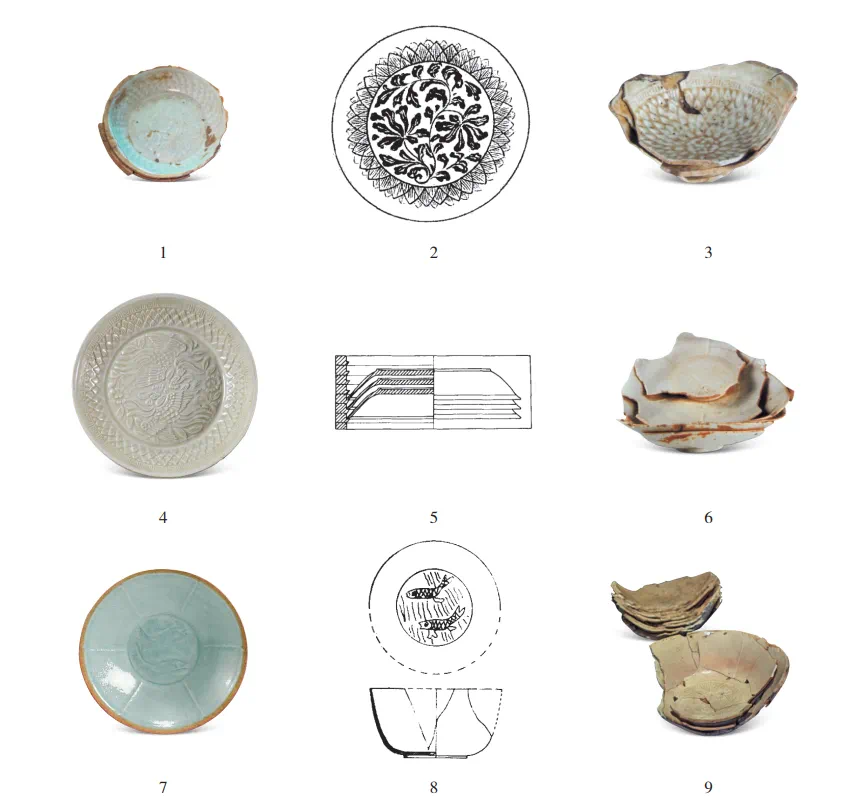
Figure 9 Hutian kiln Ab-type annular combined branch ring adhesion specimen and comparison material
1, 5, 6. Jingdezhen Folk Kiln Museum Example 2. Jiangxi Provincial Museum Example 3. Jingdezhen Hutian Example 4. National Museum of Korea Example 7. Suining Goldfish Village Example 8. Shaowu Sidu Tomb Example 9. Taoxichuan Ancient Ceramics Herbarium Example
The artifacts found at the Hutian kiln site and adhered to the Ab-shaped annular branch are generally dated to the middle and late Southern Song Dynasty. Multi-layered lotus petal patterns, water ripples and double fish patterns on the inner bottom are commonly printed on bonded objects. These patterns are related to the Wugu Lunwo Lun Tomb in Fengtai in the 24th year of Dading (1184) and the Nanhai No. 1 shipwreck (1183). A large number of Hutian kiln printing vessels found in (before and after) are all different, and the types of vessels are also quite different. Combined with the characteristic information of the relatively typical printed flat-bottomed dish from the fifth year of Shaoxi (1194) revealed earlier, it can be preliminarily judged that the popularity of the Ab-shaped ring branch should be around 1190.
Due to the small number of adherent artifacts, lack of comparable chroniclers, and limited kiln site information, it is difficult to determine the specific age of the use of this type of ring branch in other areas of Jiangxi. Mangkou blue and white porcelain found at the Nankeng kiln site in Pingxiang and Yajishan kiln site in Jing'an was found at the same time as the goblet, a typical vessel of the Yuan Dynasty. Combined with the age judgment from the excavated materials, it can be generally believed that its age should be from the late Southern Song Dynasty to the Yuan Dynasty. . Relatively speaking, the appearance of kiln sites in Hunan is clearer. For example, the multi-layered lotus petal pattern bowl TN7W19 ⑤: 16 (Fig. 10: 1) unearthed from the Yiyang Yangwuling Wajalun kiln site [80] is similar to the former Jiehutian kiln site 95A·T8 ④ A: 237, with a whirlwind pattern. The bamboo hat TN7W19 ⑤:25 (Fig. 10:2) is similar to the Jingdezhen kiln products unearthed from the Huanghuan Tomb of Shaowu in the second year of Baoqing (1226) [81] and the Zhejiang University Chemical Plant M31 in the middle and late Southern Song Dynasty (Fig. 10:3 ) characteristics are consistent [82].Based on the celadon-glazed lamp holder dated to the third year of Xianchun (1267) unearthed from the kiln, it can be roughly inferred that the Mangkou ware fired in the branch ring dates from the late Southern Song Dynasty. A small number of over-burnt mango mouth vessels and annular branch rings were unearthed from the Liling Zhonggutang kiln site Y15 [83]. Judging from the imitation Longquan kiln-style artifacts also unearthed, the age should be the Yuan Dynasty. Excavated from the Guangzhuang Maodian Kiln and Changting Nanshan Kiln in northwest Fujian, there are cloud-leaf patterns, multi-layered lotus petal patterns and phoenix patterns similar to those of the Hutian Kiln in the late Southern Song Dynasty. There are also chrysanthemum petals on the inner wall that are more characteristic of the Yuan Dynasty. The pattern folds along the plate [84]. Therefore, the age of the Ab-shaped annular branches in each region should be from the late Southern Song Dynasty to the Yuan Dynasty.

Figure 10 Ab-type annular combined branch ring adhesion specimens and comparison materials in Jiangxi and Hunan areas
1. 2. Yiyang Yangwuling Case 3. Zhejiang University M31 Case
B-type annular branches are mainly found in kilns in Fujian area. A Mangkou blue and white glaze printed bowl was unearthed from Tomb M1 of Jiang Lejishan [8 (5) Figure 11:1). The tomb was accompanied by a blue-glazed double fish wash from the Longquan Kiln of the Yuan Dynasty [86]. At the Shunchang kiln site, there is a goblet from the Yuan Dynasty produced at the same time as the branch circle. The Mangkou blue and white glaze printed wash [87] (Figure 11: 2) is collected in the Jiangle County Museum. The decoration method of stamping branch and flower patterns on the inner wall was more popular in the Longquan kiln of the Yuan Dynasty. For example, in the second year of Zhizhi (1322), Ling A disk with a lotus pattern was unearthed from Shouzheng Cemetery [88] (Figure 11: 3). There are also some Mangkou blue and white porcelain from Fujian kilns that may date back to the Southern Song Dynasty, such as the Jiangle kiln printed bowl unearthed at Banyangjiao No. 1 [89] (Figure 11: 4, 5) and the black glaze with Southern Song characteristics. The lamp [90] comes out together.Due to the lack of tombs and shipwreck materials with age information for products in Fujian, it is currently roughly believed that they are mainly from the Yuan Dynasty, and a small number of them can be as early as the late Southern Song Dynasty. In addition, the thick pink-green glaze specimen unearthed from the Longquan Xikou kiln site and adhered to the B-shaped ring branch (Figure 5:4) should not be earlier than the mid-Southern Song Dynasty.
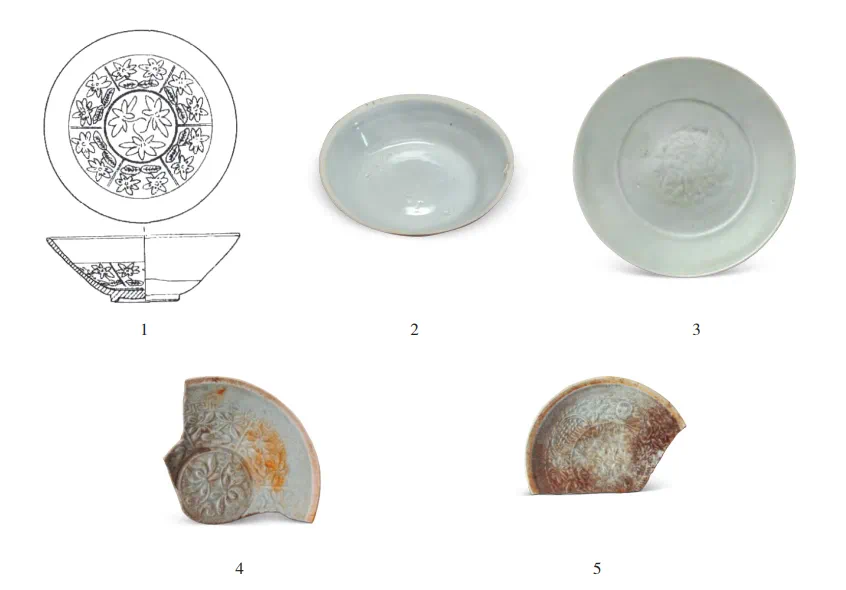
Figure 11: B-type ring-shaped firing utensils and comparative materials
1. Example of Jiangle Jishan M1 2. Example of Jiangle County Museum 3. Example of Lingshou Zheng Cemetery 4, 5. Example of Banyangjiao No.1
3 Stages of branch circle covering and burning method
Through the previous analysis of the distribution locations and usage years of various types of branch rings in each kiln, the branch ring overlaying method can be studied in stages, so as to grasp the overall development of this firing method.
(1) The first period: late Northern Song Dynasty to early Southern Song Dynasty (Jin Dynasty)
(1100-1170)
This period is the earliest stage of overfiring of branch rings. The types include A-shaped disc-shaped branch rings. They probably first appeared in Ding kiln and were dated no later than the late Northern Song Dynasty. In the late Song Dynasty and early Jin Dynasty, the kiln spread from Ding kiln southward to the kilns north of the Yellow River in northern areas such as Jingxing kiln, Guantai Cizhou kiln, Yuxian Ciyaopo kiln and Xiuwu Dangyangyu kiln (Figures 1 and 2).
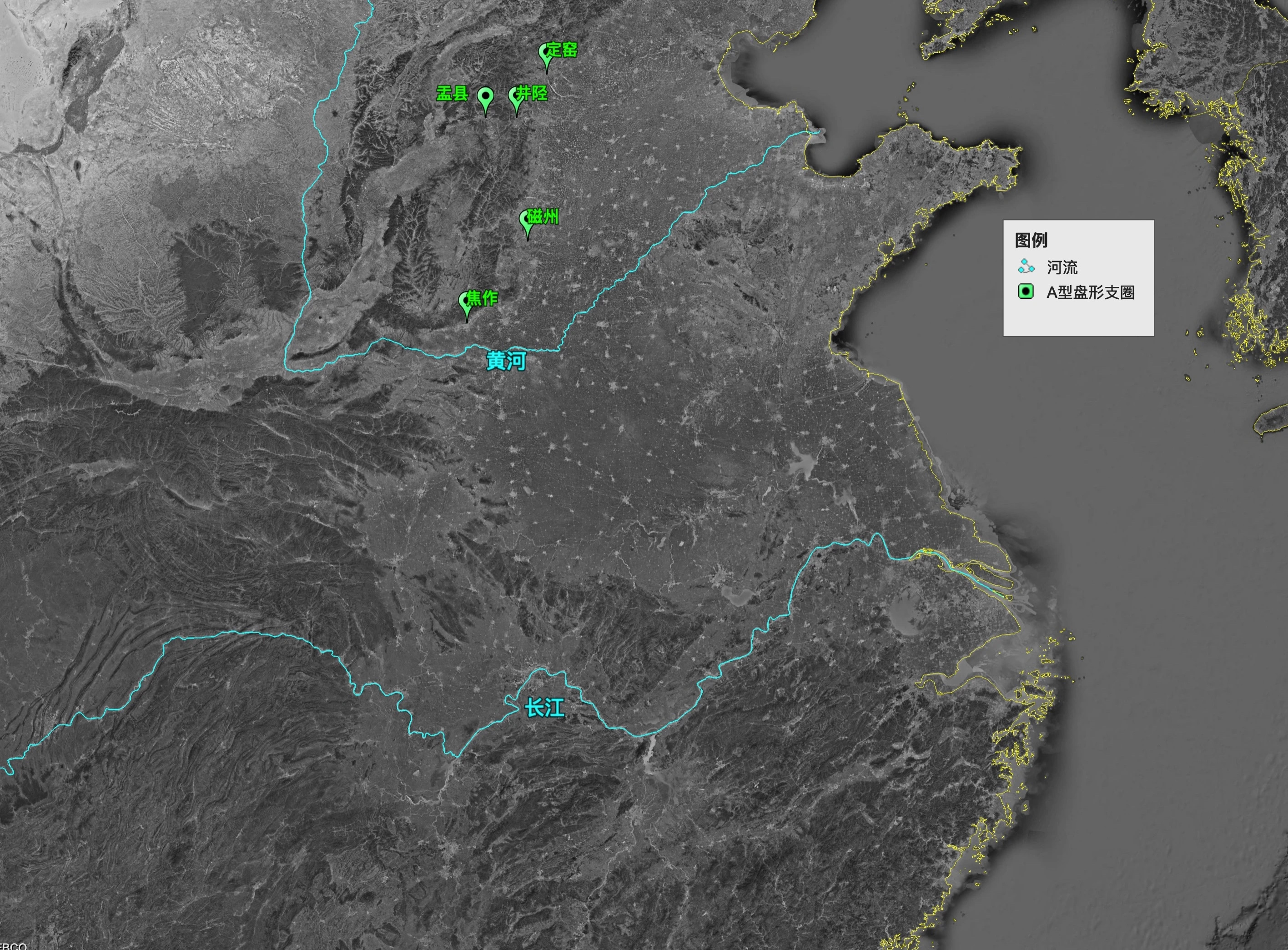
Figure 12. Late Northern Song Dynasty to early Southern Song Dynasty (Jin Dynasty) (1100-1170)
(2) The second period: the middle period of the Southern Song Dynasty (Jin Dynasty)
(1171-1189)
The main popular types of support rings in this issue are B-type disc-shaped support rings and Aa-type annular combination support rings. Characterized by multi-level ridges, the B-shaped disc-shaped branch ring, often referred to as "multi-level bowl", is mostly found at the Hutian kiln site in Jingdezhen and began roughly during the Xiaozong period of the Southern Song Dynasty (1163-1189). This type of disc-shaped branch ring is not widely spread, and only a small amount has been found at the Taishun kiln site in Zhejiang. With the emergence of annular combined branch rings, the disk-shaped branch rings in the northern region of this period gradually declined. The latter was rarely used in the northern region after entering the middle Jin Dynasty, and it may have been used in small quantities in the southern region until the 13th centuryThe Aa type annular combined branch ring should be the earliest type to appear, and it is speculated that it was created and fired in the Dingyao kiln of this period. This type of branch ring generally spread rapidly to Jingxing Kiln, Lincheng Kiln, Guantai Cizhou Kiln, Hebi Ji Kiln, Jiaozuo Kiln, Pacun Kiln, Cicun Kiln and other kilns in the northern region in the late Dading Dynasty. It was mainly popular in areas beyond the Yellow River. The eastern foothills of the North Taihang Mountains (Figure 13).

Figure 13. Middle Southern Song Dynasty (Jin Dynasty) (1171-1189)
(3) The third period: the middle and late Southern Song Dynasty (Jin Dynasty)
(1190-1279)
In this issue, Aa-type annular combined branch rings continue to be popular in the north, while Ab-type annular combined branch rings and B-type annular combined branch rings appear in the south. The Aa-type annular composite branch rings continued to be fired in this period, and may be more widely distributed than in the second period. Due to the existence of dating materials for adhesive products, it can be roughly determined that the Ab-type annular combined branch ring should be from the beginning of this period. Jingdezhen Hutian Kiln was probably the first kiln to use this type of branch ring.In addition, it also includes Fengcheng Shijiang Qianshi Kiln, Jizhou Yonghe Kiln, Jing'an Yajishan Kiln, Fengxin Kiln Changli Kiln, Ningdu Kiln, Yongfeng Shankou Kiln, Nanfeng Baishe Kiln, and Pingxiang Nankeng Kiln in central Jiangxi. Yiyang Yangwuling kiln, Changsha Jiumu kiln, Liling Zhonggutang kiln, Leiyang kiln and Hengdong kiln in eastern Hunan, and Guangzhuang Maodian kiln and Changting Nanshan kiln in western Fujian. The B-type ring combined branch ring also appeared in this issue. Their distribution is relatively concentrated. Except for a small amount found in Longquan kiln in southern Zhejiang, the rest are all in Fujian (Figure 14).
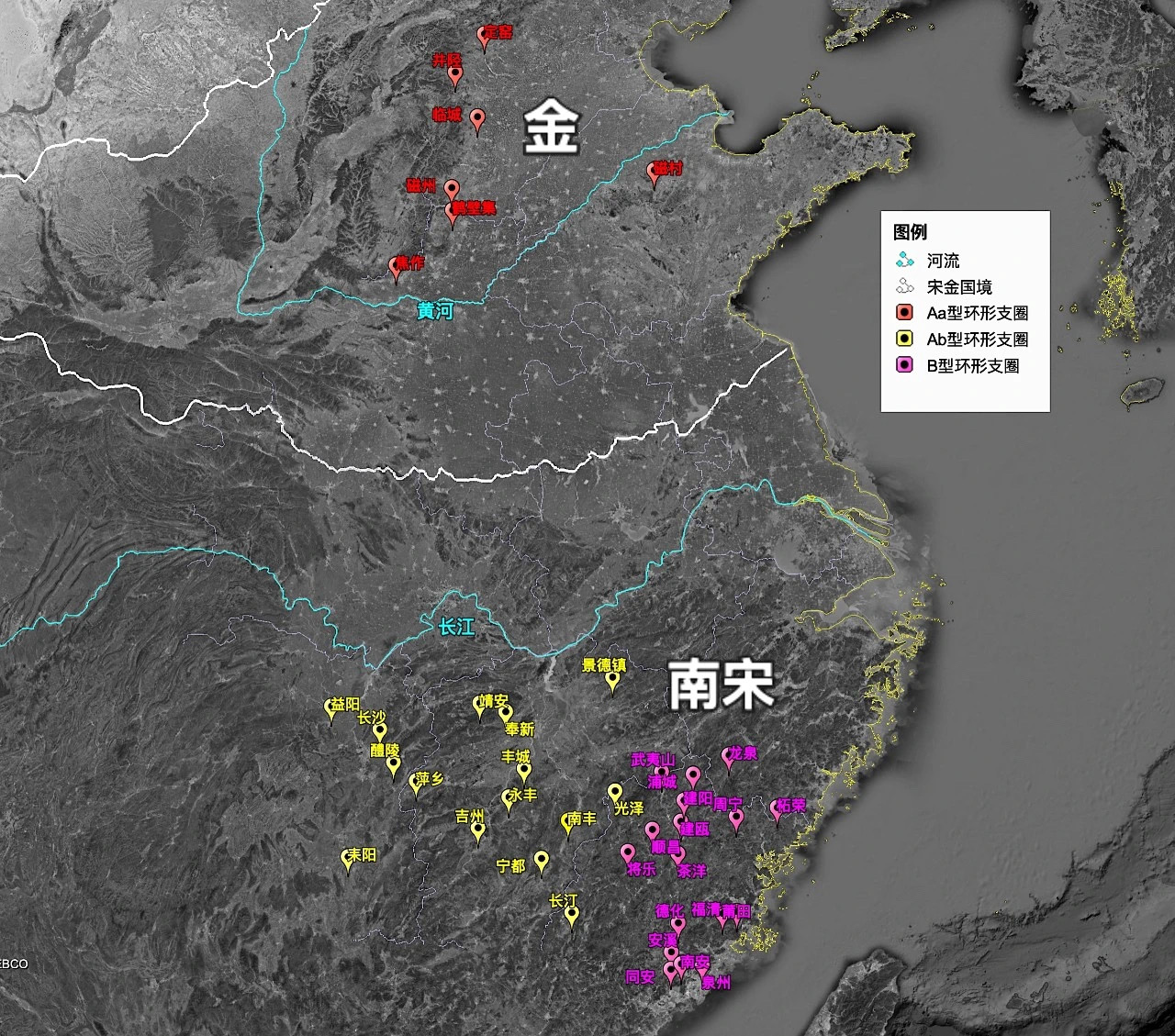
Figure 14 The middle and late Southern Song Dynasty (Jin Dynasty) (1190-1234)
4. The propagation direction of the branch ring covering method
According to the age of appearance of branch rings in each kiln and the development sequence of the overfired objects themselves, the propagation direction and path of various types of branch ring overfired methods can be discussed.
The propagation direction of the disc-shaped branch ring is relatively clear. Judging from the excavated materials and adhered artifacts at the kiln site, the A-shaped disc-shaped branch ring of the Ding kiln should be earlier than the Jingxing kiln, Cizhou kiln and Dangyangyu kiln north of the Yellow River. The A-type disc-shaped branch ring spreads from Ding Kiln to surrounding areas as a parent cultural factor. There is an age difference of about half a century when the two types of disc-shaped branch rings appeared. The design concept of the B-type disc-shaped branch ring of Hutian kiln should come from the kilns in the northern region.
Judging from dating materials, the A-shaped annular combined branches of Ding kiln and Hutian kiln both appeared in the second half of the 12th century, with the latter being slightly later. The color of the green and white glaze of the Hutian kiln was relatively stable from the late Northern Song Dynasty to the early Southern Song Dynasty. The glaze color, shape characteristics, and decorative styles of the mainstream products during this period were all very different from those of the Ding kiln. However, around the middle of the Southern Song Dynasty, Hutian kiln began to produce large quantities of The so-called "Nanding" printed products with straight white or yellowish glaze color (similar to the ivory white glaze of Ding kiln in the Jin Dynasty) are also carved with double fish and other patterns that are very different from the previous style but are almost the same as those of Ding kiln. In terms of shape, It is also very close to Ding Kiln. In the 12th century, all aspects of Ding kiln have always been in a relatively stable development trend, continuing the previous style and tradition. Considering that most of the utensils with the characteristics of Ding kiln are Mangkou, using an annular combined branch ring covering. burn,From this, we can preliminarily judge that around the late Xiaozong period of the Southern Song Dynasty, Hutian kiln products were influenced by Ding kiln in all aspects. In the process of competitive imitation, various factors such as shape, glaze color, and decorative style have undergone major changes. The annular combined branch ring covering firing method, one of the mainstream firing techniques, should also originate from the Ding kiln in the north.
Between the Jingkang Rebellion and the fall of the Jin Dynasty, there were roughly four waves of northern population migration to the Southern Song Dynasty, all of which were closely related to wars. They were the Jingkang Rebellion, the Hailing Southern Invasion, the Kaixi Northern Expedition, and the Xuanzong Southern Invasion. Some scholars have proposed that the ring-shaped combined branch ring overlaying technique spread from north to south and is closely related to the southward migration of the Jingkang Rebellion between the two Song Dynasties [91].From the chronological determination mentioned above, it can be seen that this spread should have occurred around 1190, and is not necessarily related to a certain large-scale southward migration wave in the records.
From the late Southern Song Dynasty to the Yuan Dynasty, the Ab-shaped annular combined branches of Hutian Kiln gradually spread southward to central Jiangxi, eastern Hunan and western Fujian along with its product characteristics. A bowl with "Raozhou" inscription was unearthed from the wall of the washing pool at the Yangwuling kiln site from the late Southern Song Dynasty to the early Yuan Dynasty [92], which should indicate that the utensils and decoration methods in this area are similar to those in Jingdezhen Hutian. Raozhou area is directly related. The characteristics of over-fired mangokou wares in Fujian are also close to those of Hutian kiln, but different from those of Ding kiln. Therefore, it is speculated that the firing method also originated from the Hutian kiln, and the branch ring kiln furniture was modified to a certain extent.
It is worth noting that unlike the multi-dimensional spread of ring-shaped combined branch rings accompanied by the style of artifacts, this phenomenon does not exist in the spread of disc-shaped branch rings. According to Xiong Haitang’s understanding of the levels of technology exchange in the kiln industry, compared to factors such as vessel type, variety, and decoration, the spread of firing technology represents the direct flow of porcelain craftsmen and is the deepest level of spread [93]. Generally speaking, the spread of various cultural factors of ceramics in the Song and Jin Dynasties was the most common spread of product features. Various products with cultural identity in style often use different decoration and firing methods, while utensils produced in different kilns using relatively special decoration and firing methods often have the same product characteristics [94]. There are atypical phenomena in the spread cases of disc-shaped branch rings, and analysis of the reasons requires the support of more archaeological materials.
5 Summary
This article mainly examines the issues related to the branch circle overlaying method in the Song Dynasty from an archaeological perspective. First, the branch rings are divided into two categories based on the differences in their overall shapes. The first type can be generally called disc-shaped support ring. A-type disc-shaped branch rings are found in various kiln sites north of the Yellow River. The period is generally from the late Northern Song Dynasty to the middle Jin Dynasty. B-type disc-shaped branch rings are currently only found in Jingdezhen Hutian kiln and Taishun kiln sites. According to the dating materials of the artifacts, it is estimated that they were probably formed during the Xiaozong period of the Southern Song Dynasty (1163-1189). The second type is annular combined branch ring. A-type annular combined branch rings can be divided into two subtypes.Type Aa is mainly distributed in the kilns north of the Yellow River. It appeared in the middle of the Jin Dynasty and continued into the Yuan Dynasty. The academic circles used to believe that it appeared in the late Northern Song Dynasty. There is insufficient evidence. Type Ab is widely distributed in central Jiangxi, eastern Hunan and western Fujian, and was mainly used from the late Southern Song Dynasty to the Yuan Dynasty. Type B ring-shaped combined branch rings are mainly fired in Fujian area, and the age is roughly the same as Type Ab.
From this, we can conduct a periodic study on the branch circle covering and burning method in the Song Dynasty. The first period is from the late Northern Song Dynasty to the early Southern Song Dynasty (Jin Dynasty) (1100-1170), the second period is from the middle Southern Song Dynasty (Jin Dynasty) (1171-1189), and the third period is from the middle and late Southern Song Dynasty (Jin Dynasty) (1190-1279).
Finally, the propagation direction of the branch ring covering method will be discussed. Ding kiln is in an advantageous and dominant position in the spread of branch circles, and it should be the founding kiln of disc-shaped branch circles. The installation design concept of the Hutian kiln's annular combined branch ring also originated from the Ding kiln and spread to the surrounding areas of central Jiangxi, eastern Hunan and western Fujian. Other areas in Fujian have accepted the cultural factors of the Hutian kiln’s ring-shaped combined branches to a certain extent and redeveloped them in a sublated manner.
References
[1] "Guantai Cizhou Kiln Site" compiled by the Department of Archeology of Peking University, Hebei Provincial Institute of Cultural Relics, and Handan Regional Cultural Relics Preservation Institute, Cultural Relics Press, 1997, page 443.
[2][9] Hebei Provincial Institute of Cultural Relics, Jingxing County Cultural Relics Protection and Management Office: "Archaeological Survey and Exploration Report of Jingxing Kiln Site (Part 2)", "Cultural Relics Spring and Autumn" Issue 5, 2017.
[3][11] Same as [1], page 442.
[4] Shanxi Provincial Institute of Archaeology: "Brief Report on the Investigation of the Ancient Porcelain Kiln (Ciyao Po Kiln) Site in Yuxian County, Shanxi", "Cultural Relics Quarterly" Issue 2, 1999.
[5][49] Liu Yan, Qin Dashu: "Analysis on the filling and firing methods of Dangyangyu kiln - and discussion of the exchange of filling and firing technology with Cizhou kiln", "China Dangyangyu Kiln", China Overseas Chinese Publishing House, 2010.
[6] "Jingdezhen Hutian Kiln Site 1988-1999 Archaeological Excavation Report (Part 2)" compiled by Jiangxi Provincial Institute of Cultural Relics and Archeology and Jingdezhen Kiln Museum, Cultural Relics Publishing House, 2007, color version 191.
[7] "Beautiful Light - Blue and White Porcelain from the Song and Yuan Dynasties Unearthed in Zhejiang" edited by Zhejiang Provincial Museum, China Bookstore, 2018, page 18.
[8] Hebei Provincial Institute of Cultural Relics, School of Archeology and Museology of Peking University, Quyang County Ding Kiln Site Cultural Preservation Institute: "Excavation Briefing of Area A of Ding Kiln Site in Jianciling, Quyang County, Hebei Province", "Archaeology" 2014 No.
Issue 2.
[10] Millennium Xing Kiln Editorial Committee "Millennium Xing Kiln", Cultural Relics Publishing House, 2007, page 258.
[12] "Hebi Kiln" compiled by Hebi City Cultural Relics Working Team, Zhongzhou Ancient Books Publishing House, 2009.
[13] "China Dangyang Yu Kiln" edited by Beijing Art Museum, China Overseas Chinese Publishing House, 2010, page 202.
[14] Fu Yingying: "Research on White Ground and Black Flower Porcelain from Bacun Kiln", Master's Thesis of China Academy of Art, 2006.
[15] Liu Xin, Li Baojun, and Li Ruixing: "Preliminary Study on Kiln Furniture and Decoration and Firing Technology of Cicun Kiln in Zibo, Shandong Province", "Journal of the National Museum of China", Issue 12, 2018.
[16] Peng Shanguo, Guo Zhizhong: "Porcelain making tools, kiln furniture and related issues in Chifeng Tile Kiln" "Northern Cultural Relics" Issue 4, 2000.
[17] Jiangxi Provincial Institute of Cultural Relics and Archaeology, Jingdezhen Folk Kiln Museum: "Jingdezhen Hutian Kiln Site Archaeological Excavation Report 1988-1999 (Part 1)", Cultural Relics Publishing House, 2007, page 424.
[18][70] The author took the photo at the Jingdezhen Kiln Museum.
[19] Zhang Wenjiang: "Inspection Minutes of the Shijiang Stone Kiln Site in Fengcheng City, Jiangxi Province", "Southern Cultural Relics" Issue 1, 2006.
[20] "China Jizhou Kiln" edited by Beijing Art Museum, China Overseas Chinese Publishing House, 2013, page 127.
[21][22] Chen Dingrong: "Ancient Porcelain Kiln in Fengxin, Jing'an, Jiangxi", "Archaeology" Issue 4, 1986.
[23] a. Xue Qiao, Liu Jinfeng: "Investigation of Ancient Porcelain Kiln Sites in Ningdu, Jiangxi Province", "Collection of Investigation and Excavation Reports on Ancient Kiln Sites in China", Cultural Relics Publishing House, 1984; b. Yang Qiulin: "Investigation and Preliminary Analysis of Ancient Kiln Sites in Ningdu County, China" Research", Master's thesis of Xiamen University, 2019.
[24] Yu Jiadong et al.: "Investigation of Shankou Porcelain Kiln in Yongfeng County", "Southern Cultural Relics" Issue 3, 1983.
[25] Jiangxi Provincial Cultural Relics Task Force, Nanfeng County Cultural Center: "Investigation Record of Baishe Kiln in Nanfeng, Jiangxi", "Archaeology" Issue 3, 1985.
[26] Chen Dingrong: "Investigation of the Ancient Kiln in Nankeng, Pingxiang", "Southern Cultural Relics" Issue 1, 1983.
[27][80] Hunan Provincial Institute of Cultural Relics and Archeology, Yiyang Municipal Cultural Relics Management Office: "Brief Report on the Excavation of Area II of the Wazhalun Kiln Site at Yangwuling, Yiyang, Hunan", "Hunan Archeology Series (Volume 11)", Science Publishing Society, 2015.
[28] Zhu Bang: "Investigation Brief on Song and Yuan Kiln Sites in Jiumu Village, Changsha", "Journal of Hunan Provincial Museum (Sixteenth Series)", Yuelu Publishing House, 2020.
[29][83] School of History, Renmin University of China, Hunan Provincial Institute of Cultural Relics and Archaeology, Liling Kiln Management Office: "Brief Report on the Excavation of the Yuan Dynasty Kiln Site at Zhonggutang in Weishan, Liling, Hunan", "Cultural Relics" Issue 5, 2021.
[30] Hengyang Municipal Museum: "Investigation Record of Moxing and Taiping Kiln Groups in Leiyang, Hunan Province", "Archaeology" Issue 8, 1989.
[31] "Hunan Ancient Tombs and Ancient Kiln Sites" compiled by Zhou Shirong, Yuelu Publishing House, 2004, page 448.
[32][84] Huang Fulian compiled "A Collection of Ancient Ceramic Specimens in Fujian, China—Guangshi Kiln", Fujian Fine Arts Publishing House, 2005.
[33] Deng Murong: "Song Dynasty Kiln Site Discovered in Nanshan, Changting, Fujian", "Southern Cultural Relics" Issue 4, 1993.
[34] "Wuyishan Ancient Kiln Sites" compiled by the Underwater Archeology Research Center of the National Museum of China, the Institute of Cultural Relics and Archeology of Fujian Museum, and the Wuyishan Municipal Museum, Science Press, 2015.
[35] Including Shanglanmen Kiln and Geji Kiln. See "Specimens of Ancient Chinese Kiln Sites in Fujian from the Palace Museum Collection (Part 1)" edited by Feng Xiaoqi, Palace Museum Publishing House, 2016, p. 312.
[36] Same as [35], page 346.
[37] Same as [35], page 381.
[38] Same as [35], page 576.
[39][42] Xiao Fan: "Ceramic Decoration and Firing Technology in Fujian Song and Yuan Dynasties", Master's thesis of Guangxi Normal University, 2013.
[40] a. Jianou County Cultural Center: "Investigation Brief on Xiaosong Song Dynasty Kiln Site in Jianou, Fujian", "Fujian Cultural Museum" Issue 1, 1983; b. "Nanping Cultural Relics" compiled by the Nanping CPPCC Culture and History Committee and Nanping Culture and Publishing Bureau, Nanping Culture and Publishing Bureau, 2004, p. 19.
[41] a. Ke Fengmei and Chen Hao: "Ancient Kiln Site in Putian, Fujian", "Archaeology" Issue 7, 1995; b. "Putian Kiln" edited by Lin Yuanping, Fujian Fine Arts Publishing House, 2005; c. "The Palace Museum" edited by Feng Xiaoqi Collection of Specimens from Ancient Chinese Kiln Sites in Fujian (Central)", Palace Museum Press, 2016, p. 701.
[43] a. Same as [39]; b. Same as [41]c, page 1049.
[44] a. Chen Jianzhong, Chen Lifang: "Ceramics Unearthed from Jiachunling Kiln in Dehua, Fujian", "Cultural Relics" Issue 12, 2005; b. "Dehua Kiln" edited by Chen Jianzhong, Fujian Fine Arts Publishing House, 2005; c. Same as [41]c, page 845.
[45] Fujian Provincial Local Chronicles Compilation Committee: "Fujian Provincial Chronicles·Cultural Relics Chronicles", Local Chronicles Publishing House, 2002.
[46] "Fujian Tingxi Kiln" edited by Fu Songliang and Lin Yuanping, Lingnan Fine Arts Publishing House, 2002.
[47] Shen Yueming: "Longquan kiln thick glaze technology and the firing of pink celadon glaze porcelain", "Journal of the Palace Museum", Issue 5, 2020.
[48] Qin Dashu, Gao Meijin, and Li Xin: "A Preliminary Study on the Development Stages of Dingyaojian Ciling Kiln Area", "Archaeology" 2014 Issue 3.
[50] Zhang Zhenhai et al.: "Cizhou Kiln Series Ceramics Unearthed in Linzhou City, Henan Province", "Collection", Issue 8, 2014.
[51][69] Liu Xinyuan: "Preliminary Study on Song and Yuan Mangkou Porcelain and Overfiring Technology in Jingdezhen", "Archaeology", Issue 6, 1974.
[52] Liu Xinyuan: "Study on the Shape Characteristics and Origin of Typical Bowls from Various Periods of Jingdezhen Hutian Kiln", "Cultural Relics", Issue 11, 1980.
[53] Same as [6], color version 41.
[54] "Archaeological Report of Nanhai No. 1 Shipwreck - Excavation in 2014-2015 (Part 1)" compiled by the Underwater Cultural Heritage Protection Center of the State Administration of Cultural Heritage and others, Cultural Relics Press, 2018, page 181.
[55] Same as [6], color version 23.
[56] Inner Mongolia Institute of Cultural Relics and Archaeology, Chifeng Municipal Museum: "Cleaning Notes on the Tomb of Liao Xiaofu Lord of the Yue Family in Ningcheng County", "Inner Mongolia Cultural Relics and Archeology Collection (3rd Series)", Science Press, 2004.
[57] a. Li Zhiyan, Tong Yan: "Ceramics Unearthed from the Northern Song Dynasty Chronicle Tomb in Wuyi County, Zhejiang Province", "Cultural Relics", Issue 8, 1984; b. Same as [7], page 29.
[58] Chuxian Regional Administrative Office Cultural Bureau, Quanjiao County Cultural Bureau: "Northern Song Dynasty Tomb of Western Stone in Quanjiao, Anhui", "Cultural Relics" Issue 11, 1988.
[59] "Jiangxi Song Dynasty Chronological Tombs and Chronological Blue and White Porcelain" compiled by Jiangxi Provincial Museum, Cultural Relics Press, 2016, page 103.
[60] Wang Shancai and Chen Hengshu: "Brief Report on the Cleaning of the Northern Song Dynasty Stone Chamber Tombs in Macheng, Hubei Province", "Archaeology" Issue 1, 1965.
[61] Same as [59], p. 169.
[62] Same as [54], pp. 181-182.
[63] Objects with deep belly and small flat bottom are more common in Fanchang kiln, which is closer to Quanjiao’s tomb. Because the blue and white glaze of Fanchang kiln is easy to fall off and the glaze layer at the mouth edge is thin, the artifact is described as "Mangkou" in the briefing. Fanchang kiln in the Northern Song Dynasty has been excavated many times, and no various kinds of branch ring kiln furniture have been found. The utensils similar to those in Quanjiao's tomb were all fired. The author did not find similar products in the excavation report of the Hutian kiln site in Jingdezhen. However, the excavated location of the Poyang tomb is close to the Hutian kiln site, so it cannot be ruled out that it was fired at the kiln.
[64] "Ding Kiln - The Elegant and White World" compiled by Osaka Municipal Museum of Oriental Ceramics, Japan, Osaka Municipal Museum of Oriental Ceramics, Japan, 2013, page 191.
[65] Jilin Provincial Museum, Nong'an County Cultural Management Office: "Cultural Relics from the Jin Dynasty in Nong'an, Jilin", "Cultural Relics" Issue 7, 1988.
[66] Jilin University Frontier Archaeological Research Center, Hebei Provincial Institute of Cultural Relics, and Huanghua Municipal Museum compiled "Chinese Porcelain Auspicious Colors: Cultural Relics Unearthed from the Site of Haifeng Town, Huanghua City", Science Press, 2016, page 38.
[67] "Porcelain Unearthed from the Jining Road Ancient City Site in Inner Mongolia" compiled by the Institute of Cultural Relics and Archeology of the Inner Mongolia Autonomous Region, Cultural Relics Publishing House, 2004, page 161. Jining Road was built in the Yuan Dynasty. It was originally located in Jining County in the Jin Dynasty. It was built in the third year of Mingchang (1192) of Zhangzong in Jin Dynasty. It was a town affiliated with Fuzhou in Datong Prefecture of Xijing Road in Jin Dynasty.
[68] Yu Luyang: "Research on Porcelain in the Central Plains Region of the Jin Dynasty", PhD thesis of Nankai University, 2020.
[71] "Blue and White Porcelain of the Song and Yuan Dynasties" compiled by Peng Shifan, Zhuang Wanli Cultural Foundation, 1998, p. 67.
[72] Same as [6], color version 29.
[73] According to the official website of the National Museum of Korea.
[74] Same as [17], page 427.
[75] Same as [6], color version 192.
[76] "Suining Goldfish Village Southern Song Dynasty Cellar (Part 2)" compiled by Chengdu Institute of Cultural Relics and Archaeology and Suining Municipal Museum, Cultural Relics Publishing House, 2012, plate 164.
[77] Fujian Provincial Museum, Shaowu City Museum: "Brief Briefing on Cleaning up Song Tombs in Four Capitals of Shaowu", "Fujian Cultural Museum", Issue 1-2, 1991.
[78] Collection of Taoxichuan Ancient Ceramics Specimen Museum (in preparation). The author took the photo at the "Yiding Remains Fragrant - Special Exhibition of Beige Glaze Porcelain from the Song and Yuan Dynasties" at the China Ceramics Museum in Jingdezhen.
[79] Beijing Municipal Cultural Relics Task Force: "Brief Report on the Excavation of the Golden Tombs in Beijing", "Beijing Cultural Relics and Archeology", compiled and printed by the editorial team of the Beijing History and Archeology Series, 1983, pp. 55-72.
[81] Fujian Museum, Shaowu City Museum: "Report on the Excavation of Huang Huan's Tomb in Shaowu Song Dynasty", "Fujian Wenbo" Issue 2, 2004.
[82] "Leave Traces of Song Dynasty: An Exhibition of Fine Cultural Relics from the Two Song Dynasties" compiled by Hangzhou Museum, Cultural Relics Publishing House, 2018, page 99.
[85] Fujian Museum, Jiangle County Museum: "Brief Report on the Excavation of Jishan Song and Yuan Dynasty Tombs in Jiangle County", Fujian Cultural Museum, Issue 4, 2009. The tomb was also accompanied by a stone inkstone engraved with the year "Jiyou", which is presumed to be the second year of Zhida (1309).
[86] The Longquan Kiln Pisces Wash was fired no earlier than the Yuan Dynasty. See Liu Jingxian: "Research on the Double Fish Washing in Longquan Kiln", "Oriental Museum" Issue 1, 2015.
[87] Exhibits in the 2019 "Charm of Porcelain in Happy Earth—Fujian Jiangle Kiln Cultural Relics Exhibition" at the Sackler Museum of Archeology and Art at Peking University. The author took the photo at the exhibition site.
[88] "Blue Time—An Atlas of Zhejiang Chronological Porcelain Unearthed across the Country" compiled by Zhejiang Provincial Museum, Cultural Relics Press, 2017, page 306.
[89] "Fujian Coastal Underwater Archaeological Survey Report (1989-2010)" compiled by the Underwater Cultural Heritage Protection Center of the State Administration of Cultural Heritage and others, Cultural Relics Press, 2017, page 280.
[90] Black-glazed lamps with very similar characteristics were unearthed from the shipwrecks of Banyangjiao No. 1 and Huaguangjiao No. 1. A large number of artifacts unearthed from the latter coincided with those unearthed from the Nanhai No. 1 shipwreck in the early and middle Southern Song Dynasty.
[91] Hu Xueqi: "Population Migration in the Song and Yuan Dynasties and the Southern Transmission of Porcelain Branch Ring Overlay Firing Technology", "Ceramic Science and Art", Issue 11, 2015.
[92] Yang Ningbo: "New evidence of Jingdezhen pottery craftsmen entering Hunan", China Cultural Relics News, August 29, 2014.
[93] Xiong Haitang edited "Research on the History of Technical Development and Exchange of East Asian Ceramic Industry", Nanjing University Press, 1995.
[94] For example, the Cizhou Kiln, Jiaozuo Kiln, and Lincheng Kiln of the Jin Dynasty all fired printing vessels with a strong Ding Kiln style. They used multi-stick nails or astringent circles with local characteristics, rather than the Ding Kiln style. The method of covering and burning the support circle. Most of the utensils fired with branch rings in the northern region have strong Ding kiln characteristics.



